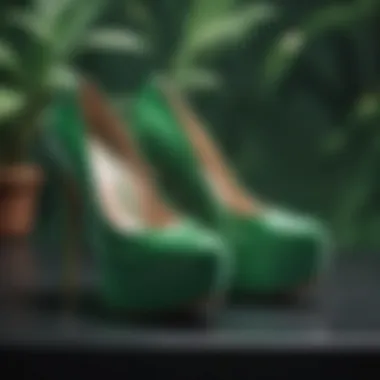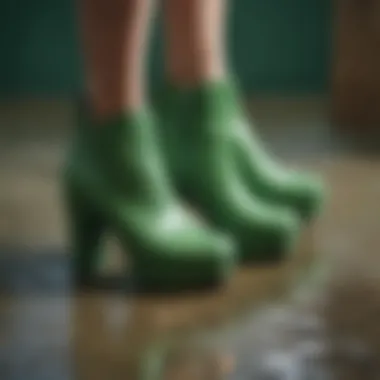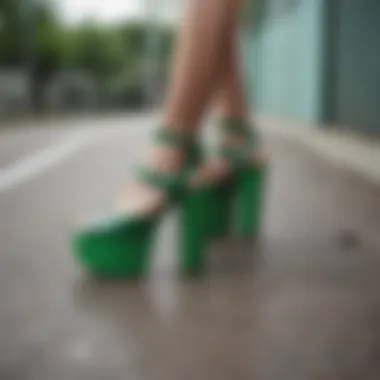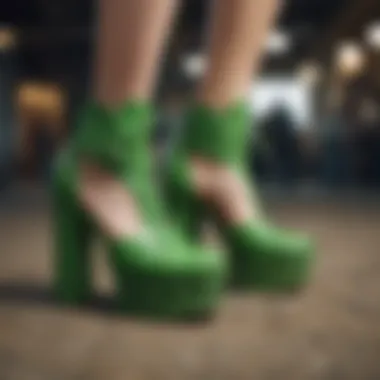Exploring Green Platform Shoes: A Comprehensive Guide


Intro
In the ever-evolving landscape of footwear, green platform shoes stand out like a lighthouse in a storm. Their appeal is not just rooted in style but connects deeply with the increasing demand for sustainability in fashion. Anyone who's paying attention knows that today's consumers aren't just looking for aesthetics; they want to wear their values. This article aims to unpack the rich narrative behind green platform shoes, exploring their history, fashionable variations, and their crucial role in modern eco-conscious practices.
Why focus on green? The color is often associated with renewal and the environment, making it a fitting choice for a movement that champions sustainability. Whether you are a fashion aficionado or a retail industry professional, acknowledging the intricate blend of design and sustainability in shoes can elevate your understanding and appreciation of contemporary fashion trends.
We'll look at how these shoes have carved out their niche in the market, the shifting expectations from consumers, and the vital relationship between fashion and sustainability. Let’s set the stage by diving into the latest fashion trends surrounding these versatile pieces.
Intro to Green Platform Shoes
In the evolving landscape of fashion, green platform shoes have emerged as a noteworthy component for those keen on merging style with substance. Their significance stretches beyond mere aesthetics, reflecting a broader transition towards sustainability and ethical consumerism. As consumers become increasingly aware of their environmental impact, this style represents a blend of trendy silhouette and eco-conscious practices. The relevance of this section lies in shedding light on the essentials of green platform shoes, which not only elevate one's stature but also align with modern values that prioritize eco-friendly choices.
Definition and Characteristics
Green platform shoes are characterized by their elevated soles designed to provide height and comfort simultaneously. The term "green" can refer not only to the color but also to the sustainable practices involved in their production. Generally, these shoes feature a thicker sole compared to standard footwear, which helps distribute weight evenly, thus offering more comfort during extended wear. Key characteristics to note include:
- Material Composition: Often crafted from sustainable materials such as organic cotton, bamboo, or recycled plastics, these shoes aim to lessen the carbon footprint associated with traditional manufacturing.
- Design Options: They come in a myriad of designs—from casual sneakers to more elegant heels—allowing them to be versatile across various occasions.
- Comfort Features: Many green platform shoes incorporate cushioning or arch support, addressing the need for long-term wear without compromising on comfort.
Brief History
The journey of platform shoes dates back centuries, but the "green" movement took hold more recently. The modern interpretation of platform shoes began to see traction in the mid-20th century, largely influenced by various cultural revolutions including the 1960s and 70s. As fashion designers found inspiration in diverse art and music movements, platform shoes became a symbol of individuality.
In the last couple of decades, environmental awareness surged, pushing brands to reevaluate their production methods. The early 2000s saw the inception of sustainable fashion initiatives that encouraged the use of eco-friendly materials in shoe production.
The transition from mainstream fashion to green was not instantaneous. Many retailers initially hesitated, fearing a niche market. However, as awareness grew, so did consumer demand. Consequently, the rise of brands dedicated to sustainability made green platform shoes not only a stylish choice but also an ethical one, paving the way for their current status as a staple in forward-thinking wardrobes.
Fashion Significance
The fashion relevance of green platform shoes cannot be overstated in contemporary style narratives. They act as more than just footwear; they stand as a cultural statement reflecting the intersection of aesthetics and environmental consciousness. With the growing awareness surrounding eco-friendly fashion, these shoes resonate with a clientele that appreciates both style and sustainability. Designers are increasingly emphasizing the incorporation of sustainable practices within the realm of fashion, thus making green platform shoes a pivotal element in this evolution.
Cultural Impact
Culturally, green platform shoes have made waves that reach beyond individual style choice. They embody a movement toward more thoughtful consumerism, often embraced by advocates of green living. This footwear trend reflects societal shifts toward sustainability and ethical manufacturing practices. People who wear them are often seen as trendsetters, showcasing a lifestyle that aligns with responsible consumption.
For instance, during various fashion weeks worldwide, these shoes often showcase innovative designs that speak volumes. Not only do they add height and flair, but they also echo a commitment to eco-friendly values, thus influencing public perception. The colors associated with green platform shoes also play into broader cultural narratives. Shades of green often signify renewal and balance, amplifying their desirability as a fashion statement.
Furthermore, institutions like the Council of Fashion Designers of America (CFDA) actively promote sustainable initiatives. Their campaigns often feature influencers and celebrities who sport green platform shoes, further driving the message home. The impact, thus, is multidimensional; it involves individual expression while simultaneously forwarding a collective ethos.
Trends Over the Years
Exploring trends reveals how green platform shoes have evolved since their inception. The early days saw them largely confined to specific styles – think clunky yet sometimes clumsy designs. In the late 20th century, these shoes saw a resurgence, heavily influenced by the grunge movement and punk aesthetics that celebrated bold, often ostentatious footwear. With this came a departure from traditional materials as designers began experimenting with bright colors and unconventional designs.
As we stepped into the 21st century, the trends shifted yet again. The emphasis on sustainability breathed new life into green platform shoes, driving brands to innovate not just in design but also in materials. Consider how brands like Stella McCartney have pioneered leather alternatives that are not only kind to the environment but also high on style. This merging of function and form has made it possible for consumers to embrace a new dimension of self-expression through eco-conscious choices.
Today, various styles reflect current trends; chunky soles coupled with sleek designs cater to a young, fashion-savvy audience. Social media platforms, like Instagram and Pinterest, have played a role in shaping these trends, fostering a community of like-minded individuals who champion style while promoting eco-friendly practices.
In summary, the significance of green platform shoes transcends mere fashion; they are a bastion of cultural change, evolving through trends that mirror contemporary values and aspirations.


Design Variations
Design variations in green platform shoes are pivotal, not just for aesthetic appeal but for their overall functionality and alignment with sustainable practices. From the choice of materials to the specific shapes and colors, each design aspect speaks volumes about the wearer's personality and commitment to eco-conscious living. Opting for the right design can enhance one’s personal style while ensuring that sustainability remains at the forefront.
Material Choices
Leather Alternatives
Leather alternatives are gaining ground in the realm of footwear, including green platform shoes. These materials, which may include synthetic options or plant-based textiles, provide a responsible substitute for traditional leather. One of the standout features of leather alternatives is their versatility — they can replicate the look and feel of genuine leather while often being more affordable and easier to maintain.
- Benefits of Leather Alternatives: They are typically lighter than real leather and provide a wider range of colors and textures, allowing for more creative design options.
- Disadvantages: On the flip side, they might not offer the same durability as genuine leather or may show signs of wear more quickly, which could be a concern for long-term wear.
Sustainable Fabrics
Sustainable fabrics are woven from organic resources, which means they can minimize environmental impact while still offering style and comfort. These materials could be anything from hemp and organic cotton to recycled polyester. A key characteristic of sustainable fabrics is their biodegradable nature, which means they return to the earth instead of piling up in landfills.
- Why They’re Beneficial: These fabrics represent a conscious effort towards reducing waste and promoting eco-friendliness in fashion. Wearing shoes made from sustainable fabrics shows a commitment to environmental concerns.
- Advantages and Disadvantages: While they can be eco-friendly, some sustainable fabrics may not offer the same level of performance and longevity as conventional materials. However, their positive impact on the environment often outweighs these concerns for conscientious consumers.
Heel Heights and Shapes
The heel heights and shapes of green platform shoes can significantly influence not only the silhouette but also the comfort level of the wearer. From chunky block heels that provide stability to delicate stiletto designs that exude glamour, the choice of heel can be tailored to different occasions and personal preferences.
- Considerations: Potential buyers should assess their comfort with various heel types, especially for long wear. Additionally, thicker heels can help distribute weight more evenly, reducing fatigue.
Color Shades and Textures
Colors and textures in green platform shoes can create a visual statement that complements various outfits. Common shades might include vibrant greens, earthy browns, or classic black, but there’s room for creativity with unique patterns and finishes.
- Textures: Textured surfaces, such as suede or embossed materials, can add depth to an outfit, making these shoes stand out in a crowd. For those who appreciate subtlety, matte or sleek finishes offer a refined aesthetic that aligns well with both casual and formal attire.
Styling Green Platform Shoes
Styling green platform shoes isn’t just about appearance; it’s a potent mix of creativity and self-expression. These versatile pieces can turn an ordinary outfit into a standout ensemble. More than mere footwear, they symbolize a mindset that prioritizes sustainability without compromising on flair. As consumers grow more conscientious of their choices, understanding how to style these unique shoes becomes crucial to fully embrace their potential.
Casual Looks
Dressing down with green platform shoes opens a realm of laid-back but chic possibilities. Combining comfort with style, these shoes are perfect for various casual settings, be it a brunch with friends or a stroll in the park. Think of pairing them with a pair of light-wash denim jeans and a simple graphic tee. The contrasting textures add visual depth. Alternatively, a sundress in soft pastel hues harmonizes with the vibrancy of green shoes, maintaining a fresh, effortless vibe.
- Denim jeans and a tee
- Sundresses
- Skirts and oversized sweaters
By emphasizing ease, these combinations make a bold statement while keeping it cozy. It’s also wise to consider accessories; a crossbody bag with earthy tones or a simple cap can complete the look while staying true to the eco-friendly theme.
Formal Outfits
Transitioning to a formal context with green platform shoes calls for a bit of finesse. The key is balancing elegance with a touch of individuality. These shoes can elevate a tailored blazer and trousers combination or even a sleek midi dress. For instance, consider a fitted black dress alongside green shoes that pop. This pairing not only brings a contemporary twist but also maintains a level of sophistication.
- Tailored trousers with a structured top
- A-line dresses
- Chic jumpsuits
In a world where conformity often governs dress codes, opting for striking green can become a talking point, showcasing uniqueness without veering into flamboyance. A clutch in a contrasting color can further enhance this polished yet bold look.


Seasonal Styling Tips
When considering seasonal styling, green platform shoes prove adaptable across different climates. During warmer months, pair them with light fabrics such as linen or cotton, which breathe easily. Opting for lighter greens can mirror the freshness of springtime blossoms. In cooler weather, heavier fabrics like wool blend with the structure of these shoes to create a balanced appearance.
In seasonal layering:
- Spring: Layer with a light denim jacket and a floral blouse.
- Summer: Flowy culottes paired with a cropped top.
- Fall: Knit sweaters over dresses and tights.
- Winter: Long coats with structured silhouettes and scarves.
"Your shoes are the first thing people notice about you. Make sure they tell a story."
By embracing seasonal changes, you can keep your styling relevant and expressive, ensuring your green platform shoes remain a standout piece in your wardrobe year-round.
Sustainability in Fashion
The fashion industry, as it moves forward in this modern age, increasingly faces a critical crossroads where style meets responsibility. Embracing sustainability in fashion is no longer just a trend; it has become essential for a healthier planet. In the context of green platform shoes, this aspect is particularly vital. It highlights the interconnectedness of consumer choices and their environmental footprint, showcasing how footwear can be both fashionable and eco-conscious.
As consumers become more discerning, they seek out brands that reflect not only their aesthetic preferences but also their values. The importance of sustainability manifests itself in several specific elements. It influences material sourcing, production processes, and even post-consumer life. Shifting towards sustainable practices can help reduce waste, and lower carbon emissions, all while promoting ethical labor standards.
Moreover, embracing sustainable fashion leads to critical benefits, including:
- Conservation of resources: Sustainable practices typically use fewer natural resources, reducing the strain on our planet.
- Better supply chain transparency: Knowing how and where products are made encourages responsible production and ethical labor practices.
- Long-lasting quality: Sustainable products often prioritize durability, countering the disposable culture prevalent in fast fashion.
- Consumer loyalty: Brands adopting eco-friendly methods tend to build deeper connections, attracting repeat customers who care about their choices.
By focusing on sustainability within the realm of shoes, particularly green platform shoes, we can inspire a shift in consumer behavior toward more responsible choices. It's not just about the shoe - it’s a stance on a shared future.
Eco-Friendly Production Methods
In the journey towards sustainable fashion, eco-friendly production methods play a pivotal role. The way shoes are made has a direct impact on the environment. Green platform shoes, for example, often come from materials that are sourced responsibly, minimizing harm to ecosystems.
- Plant-Based Materials: Many brands are moving to plant-based alternatives rather than traditional leather. Materials such as mushroom leather and organic cotton have gained attention for their lower environmental impact.
- Reduced Water Usage: Production techniques that lower water consumption help conserve valuable resources. Several brands are opting for dyeing methods that consume significantly less water compared to conventional processes.
- Carbon Footprint Reduction: Utilizing renewable energy in manufacturing facilities can greatly diminish the overall carbon footprint of the production process.
- Recycled Materials: Shoes made from recycled plastics or textiles can transform waste into beautiful products, thus combating landfill overflows and promoting a circular economy.
The positive ripple effects of these eco-friendly production methods extend beyond just the shoes themselves; they inspire a broader commitment to sustainability across the entire fashion industry.
Life Cycle of Green Platform Shoes
Understanding the life cycle of green platform shoes provides valuable insight into the sustainability narrative. It transcends mere aesthetics and digs deep into the stages of a product’s life, educating consumers about their choices.
- Raw Material Sourcing: This initial phase is critical, as the choice of materials directly impacts environmental health. Ethical sourcing ensures that resources come from sustainable environments.
- Production Phase: As discussed, the methods used during manufacturing determine not only the carbon footprint but also labor practices. Ethical production is key.
- Distribution: The transport of finished goods can be resource-intensive. Brands focusing on eco-conscious distribution methods can further reduce their environmental impact by choosing green logistics solutions.
- Usage: The lifespan of shoes varies greatly based on the quality and care taken by the consumer. Durable products lead to less frequent replacements.
- End of Life: Finally, the manner in which shoes are disposed of is crucial. Brands encouraging recycling or offering take-back programs can ensure that their products have a second life, minimizing landfill contribution.
"The life cycle approach is essential in fashion, as it shapes how we understand our impact—not just on the earth, but on each other."
By recognizing the life cycle of products, consumers can make more informed decisions—cultivating a deeper respect for both style and sustainability.
Market Trends
Understanding the market trends related to green platform shoes offers insight into their popularity, consumer preferences, and their overall impact on the fashion industry. As sustainability gains traction worldwide, the growth trajectory of these shoes reflects a shift in not just what people wear, but also how they think about their purchases.
"The decisions we make in fashion resonate beyond the closet, influencing not just the economy but also environmental and ethical practices."
Focusing on this aspect helps both consumers and retailers to align their choices with values that are increasingly important in our society. With each passing season, new innovations and shifts in style are observed, shedding light on how green platform shoes have evolved.


Current Popular Brands
In the realm of green platform shoes, several brands stand out for their commitment to sustainability, style, and quality. Here’s a look at a few noteworthy mentions:
- Veja - Known for using organic materials and fair trade practices, Veja offers a range of platform sneakers that blend fashion with sustainability.
- TOMS - With its well-known mission of social responsibility, TOMS produces platform shoes that are not only fashionable but also support various initiatives across the globe.
- Allbirds - This brand has carved a niche by utilizing merino wool and eucalyptus tree fiber to create comfortable, eco-friendly shoes, including stylish platform options.
- Dr. Martens - While historically known for their rugged boots, their foray into platform shoes makes them a key player in the sustainable market as they adopt greener production methods.
- Native Shoes - With an emphasis on using recycled materials and ethical production, Native Shoes has launched a collection of platform styles that appeal to eco-conscious consumers.
These popular brands not only showcase the aesthetic appeal of green platform shoes but also highlight the importance of ethical manufacturing practices.
Price Range and Accessibility
When it comes to price, green platform shoes occupy a wide range, allowing accessibility for various budgets. Generally, the cost falls between $60 to $300, depending on factors such as materials used, brand reputation, and design complexity. Breaking it down:
- Budget-friendly options: Available for as low as $60, brands like TOMS offer stylish choices that won't break the bank.
- Mid-range selections: For those willing to invest a bit more, brands like Veja and Native Shoes typically range from $100 to $150, providing a mix of innovation and sustainability.
- High-end offerings: Designer brands focusing on exclusive materials and artisanal craftsmanship may charge between $200 and $300.
This diversity in pricing ensures that consumers can find suitable options without sacrificing their eco-friendly values. Additionally, many brands have embraced online sales platforms, making it easier than ever to purchase sustainable shoes from the comfort of home.
Consumer Considerations
When it comes to fashion, especially regarding shoes, various factors deserve attention from consumers. Green platform shoes are no exception. Understanding their composition, comfort, and fit not only enhances the overall wearing experience but also allows buyers to make informed decisions. Keeping an eye on these aspects helps in ensuring that the investment made in footwear aligns with individual priorities, especially those revolving around comfort and sustainability.
Evaluating Quality and Comfort
Quality and comfort can significantly affect how we perceive and enjoy our footwear. With green platform shoes, this becomes even more critical due to their unique materials and construction. Often crafted with eco-friendly alternatives, assessing the quality goes beyond mere aesthetics. Here are a few aspects to consider when evaluating:
- Material Durability: Look closely at the materials used. Shoes made of high-quality sustainable fabrics or leathers can provide more comfort while being environmentally friendly.
- Padding and Support: Quality shoes often comprise adequate cushioning. Ensure that the insoles are soft yet supportive. After all, no one wants sore feet by the end of a day.
- Breathability: Shoes that allow the feet to breathe contribute significantly to comfort. Fabrics that wick moisture can prevent unwanted odors and discomfort during long wear.
A tip is to always try on the shoes before buying, if possible. Walk around for several minutes and pay attention to any immediate discomfort. Comfort is subjective, so what works for one may not for another. Furthermore, the weight of the shoes should be considered as well—lightweight options often lead to a more pleasant wearing experience.
Sizing and Fit Tips
Finding the right size and fit is crucial when choosing green platform shoes. It sounds simple, but many people stumble over this step, which can lead to dissatisfaction and discomfort. Here are key tips for ensuring a good fit:
- Measure Your Feet: Always measure your feet before making a purchase. Feet can change over time, so ensure you're using the most accurate measurements.
- Check Size Charts: Different brands can have slight variations in sizing. Consult their specific size charts for better accuracy.
- Consider Width: Feet come in different widths. If you find traditional sizes uncomfortable, look for brands that offer wide or narrow fits.
- Try On with Appropriate Socks: If you normally wear thicker socks, it’s a good idea to try shoes on while wearing similar thickness.
- Heel Slippage: Pay attention to whether your heel slips out of the back of the shoe. Ideally, the fit should be snug without constricting.
As the saying goes, "better snug than sorry!" This is definitely true with footwear. Regardless of the style the shoes offer, if they don't fit well, they won't be loved as they should be. So, investing time into achieving the right fit can save both frustration and foot pain.
"Quality wear is born from a balance of comfort and fit. Always prioritize both when choosing shoes to walk in style and confidence."
Understanding these consumer considerations equips fashion enthusiasts and retail professionals with the knowledge needed to appreciate and happily wear green platform shoes. As the green movement continues, being mindful of each step in the process of selecting the right footwear remains essential.
Finale
The conclusion of this article ties together the threads of our exploration into green platform shoes. It emphasizes the key takeaways around their significance, sustainability, and the future landscape of the fashion industry. This becomes essential not only for consumers but also for professionals working within retail, design, and sustainability sectors.
The Future of Green Platform Shoes
As we look ahead, the future of green platform shoes appears promising, shaped by both consumer demand and industry innovation.
- Increased Demand for Sustainable Choices: Today's consumers are notably more aware of their impact on the environment. This consciousness is pushing brands to adopt greener practices. Consequently, the materials utilized in manufacturing green platform shoes are becoming increasingly eco-friendly. Expect to see more options crafted from recycled materials or organic textiles.
- Technological Innovations: Advancements in technology are leading designers to create shoes that blend style with sustainability seamlessly. New methods in production are reducing waste and improving quality, ensuring better performance and longevity, which is always a plus for wearers.
- Broader Acceptance in Fashion: Green platform shoes are transitioning from a niche market to mainstream fashion. As more designers experiment with styles, colors, and prints, consumers will find more opportunities to express personal style while supporting environmentally sound practices.
"Green is not just a color anymore; it's a lifestyle and a trend that reflects what we value as a society."
- Supporting Local Economies: Many brands are starting to emphasize local production. This not only cuts down on carbon footprints from shipping but also boosts local economies. It means that consumers can feel good about their purchases supporting artisans and small business owners.
In summary, the future for green platform shoes holds a multitude of exciting possibilities. The melding of fashion and eco-consciousness is not just a trend; it's a significant movement that is reshaping our choices and how we view style. As awareness grows, so does the need for thoughtful consumerism that all of us can embrace.







